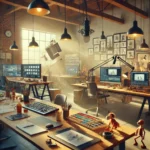In the world of filmmaking, lighting is not merely a technical requirement—it is one of the most crucial storytelling tools. From shaping a film’s mood to guiding the audience’s emotional journey, lighting creates atmosphere and depth, elevating a simple scene into a powerful visual experience. Mastering the art of lighting allows filmmakers to direct the viewer’s focus, define characters, and emphasize the narrative. This article delves into why lighting is vital in filmmaking and explores its many roles in crafting a film’s visual language.
Lighting Sets the Mood and Atmosphere
Lighting plays a pivotal role in establishing the mood of a scene. The intensity, color, and direction of light can evoke different emotions—whether it’s the harsh, cold light that builds tension in a thriller or the soft, warm tones that create intimacy in a romance. Low-key lighting, often characterized by strong contrasts and shadows, is commonly used in horror or noir films to enhance suspense. Conversely, high-key lighting, which is bright and even, is used in comedies or light-hearted dramas to evoke a sense of openness and cheerfulness.
Filmmakers use different types of lighting to manipulate the atmosphere in ways that resonate with the genre, helping to immerse the audience in the world of the film.
Guiding the Viewer’s Eye
One of the primary functions of lighting in filmmaking is to guide the audience’s attention. Through careful positioning of lights, filmmakers can direct the viewer’s gaze to important details in the frame. Bright areas typically draw more attention, while shadowed or dimly lit sections can subtly shift focus away from less relevant elements.
Techniques like the use of backlighting can make a character appear more heroic or mysterious by highlighting the outline, while practical lighting—using light sources like lamps within the frame—adds realism and naturally directs the viewer’s eye. This ability to control focus is essential for storytelling, as it allows filmmakers to emphasize specific emotions, actions, or plot points.
Creating Depth and Dimension
Lighting is key to adding depth to a two-dimensional medium like film. Through the strategic use of light and shadow, filmmakers create the illusion of three-dimensionality, enhancing the visual impact of each scene. Techniques like three-point lighting, which consists of a key light, fill light, and backlight, are used to sculpt subjects and give them form. This technique prevents flat, uninteresting visuals by ensuring the subject is properly illuminated from different angles.
In addition to three-point lighting, chiaroscuro lighting—contrasting light and dark areas—adds dramatic tension to scenes by creating sharp differences between foreground and background elements. These methods ensure that characters and objects have volume, making the world of the film feel more lifelike.
Defining Characters and Themes
Lighting is also a powerful tool for defining characters and emphasizing the thematic elements of a story. For instance, a character in deep shadow may symbolize moral ambiguity or hidden motives, while bright, even lighting can suggest innocence or clarity. Filmmakers often experiment with lighting to visually communicate a character’s internal struggle or transformation without the need for dialogue.
In thematic terms, the manipulation of light can reflect broader ideas in the narrative. In films dealing with complex moral questions or duality, lighting is frequently used to highlight the contrast between light and darkness, good and evil. By playing with these elements, directors can subtly convey themes that resonate deeply with viewers.
Lighting as a Storytelling Tool
In filmmaking, every choice should serve the story—and lighting is no exception. The way a scene is lit can significantly alter how the narrative is perceived. In some cases, filmmakers will intentionally use unconventional lighting setups to challenge expectations or add layers of meaning. For example, using stark, unnatural lighting can unsettle the audience or signify a break from reality, as seen in many surreal or avant-garde films.
Moreover, lighting can be used to signal changes in the story’s tone or direction. A gradual shift from soft, natural light to harsh, artificial light might indicate a character’s descent into conflict or madness. In this way, lighting becomes an active participant in storytelling, constantly evolving to reflect the shifts in mood and plot.
Lighting is one of the most vital components of filmmaking, shaping not only the visual appeal but also the emotional and thematic depth of a film. By mastering lighting techniques, filmmakers can create compelling scenes that evoke strong emotional reactions, define characters, and enhance the narrative flow. Whether you’re crafting a high-energy action scene or a quiet moment of introspection, the careful manipulation of light can make all the difference. Understanding its importance will help aspiring filmmakers tell more engaging and visually captivating stories.


